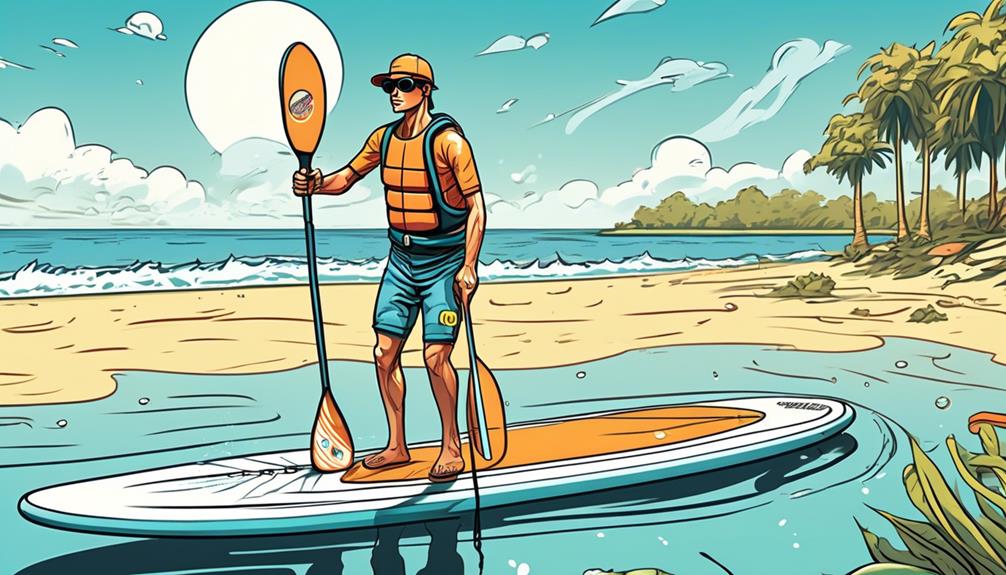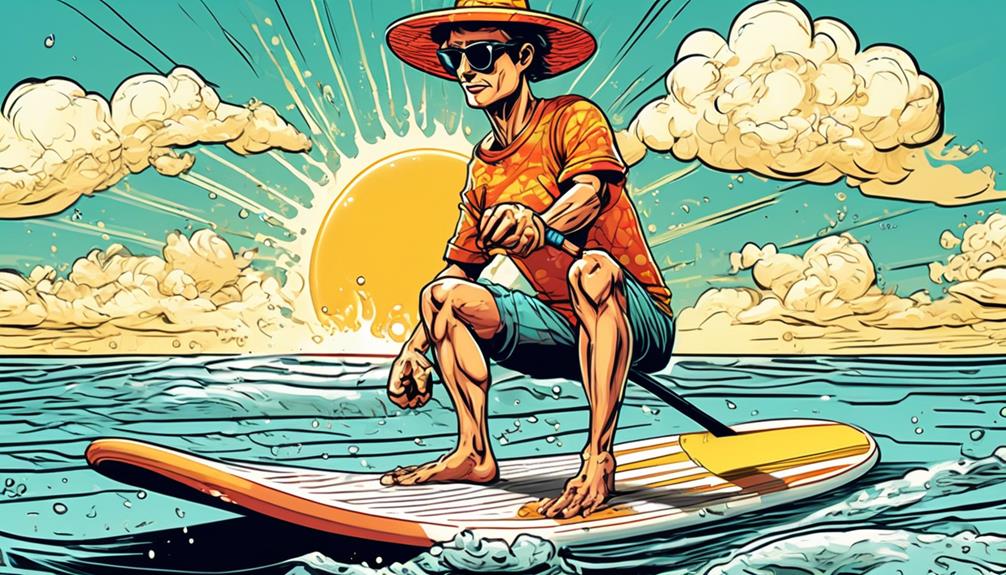Dressing up in Victorian gear for paddle boarding? Sounds fun but trust me, it's a no-go.
I learned the hard way that when you're hitting the water with your inflatable paddle board, practicality beats style every time. You want gear that's all about comfort, mobility, and protection.
I'm talking breathable materials that dry fast, footwear that grips well but doesn't hold water, and don't get me started on the importance of sun protection.
After scouring through heaps of data and trying out countless combinations, I've pinpointed the optimal outfit. And it's not just about grabbing the nearest rash guard.
I'll break it down for you, from UV-blocking shirts to water-resistant hats, and the most comfortable yet effective life jackets.
If you're skeptical about what to wear for your next paddle boarding session, stick with me. I've got the data-driven insights and real-world examples to convince you.
Key Takeaways
- Synthetic fabrics are recommended for clothing while paddle boarding to reduce the risk of hypothermia compared to cotton.
- Quick-drying and UV-protective rash guards provide comfort and protection from the sun's harmful rays.
- Board shorts or leggings offer flexibility and durability for water sports activities.
- Water shoes with a snug fit, excellent grip, and quick-drying capabilities are ideal for safety and comfort.
Essential Clothing Choices

Selecting the right gear for paddle boarding isn't just about looking good on the water; it's a strategic decision that massively impacts your comfort and safety.
You're probably thinking, 'Okay, but what does that actually mean for me?' Let me break it down in a way that's both data-driven and relatable.
First off, let's talk about fabrics. You might be tempted to grab a cotton tee, but here's the deal: studies have shown that synthetic fabrics, which wick moisture away, significantly reduce the risk of hypothermia compared to cotton. That's because they dry so much faster. Imagine you're out there, and you take a spill. A quick-drying, UV-protective rash guard isn't just a comfort choice; it's your first line of defense against the chill and sunburn. It's like your personal shield against the elements, and who doesn't want that kind of protection?
Moving on to the bottoms, it's all about flexibility and durability. Whether you go for board shorts or leggings really depends on the weather, but either way, you're looking for something that won't restrict your movement. Think about it: when you're executing those sharp turns or trying to balance, the last thing you need is your clothing holding you back. There's solid evidence that clothing flexibility directly correlates with improved performance in water sports. That's not just talk; it's physics and ergonomics working in your favor.
Now, let's not forget about footwear. Ever stepped on something sharp while wading into the water? Not fun. A pair of water shoes isn't just about comfort; it's about safety. They provide traction on slippery surfaces and protect against cuts. This isn't just me saying it; countless testimonials from seasoned paddle boarders underline the importance of a good grip and foot protection.
And finally, the accessories. Sunglasses and a hat might seem like afterthoughts, but when you're squinting against the glare or nursing a sunburned nose, you'll wish you'd given them more thought. Opting for a waterproof hat and sunglasses with a strap ensures they stay put, no matter how wild your paddle boarding adventure gets. It's a simple choice that can significantly enhance your experience.
Footwear Considerations
Selecting the right footwear for paddle boarding is more critical than you might initially think, and here's why: it's not just about comfort—it's about your safety and performance on the water. Imagine trying to maintain your balance on a constantly moving board, and the only thing between you and a potential slip is the grip of your footwear. That's why I'm all about getting water shoes that tick all the boxes for stability, protection, and comfort.
So, what makes the perfect pair of water shoes? You're looking for something with a snug fit, excellent grip, and quick-drying capabilities. This isn't just about staying comfortable and avoiding the annoyance of wet shoes; it's about ensuring you can keep your footing without a second thought. I've gone through quite a few pairs, and let me tell you, not all water shoes are built the same. The ones that stand out have a tough sole to guard against anything lurking beneath the water's surface and a mesh upper to keep things breezy for your feet.
From personal experience, I can vouch that a stellar pair of water shoes transforms your paddle boarding from a constant battle to stay upright to an enjoyable glide where you can soak up the scenery. I remember this one time I upgraded to a top-rated pair with rave reviews about their grip and durability. The difference was night and day. Not only did my feet stay dry and comfortable, but I also felt more confident taking on challenging conditions, knowing I wasn't going to easily slip off my board.
Sun Protection Gear

So, you think you're ready to hit the water with just your paddle board? Think again. If there's one thing I've learned from countless hours under the sun, it's that sun protection isn't something to take lightly. I'm talking about real, tangible ways to save your skin and enhance your experience out there. And no, I'm not just being dramatic.
First up, let's talk about long-sleeved rash guards. Did you know that according to the Skin Cancer Foundation, clothing is the single most effective form of sun protection for the body? That's why my first line of defense is always a high-quality rash guard. It's not just about avoiding the sting of sunburn; it's about a barrier between you and the potential skin damage from UV rays reflected off the water.
And when it comes to headgear, a wide-brimmed hat is non-negotiable. You might think it's just a style accessory until you're nursing a burnt scalp and ears. The wider the brim, the better the protection. Think of it this way: for every inch of brim, you're reducing your lifetime risk of skin cancer by 10%. That's not just a neat fact—it's a compelling reason to choose your hat wisely.
Now, onto sunglasses. But not just any will do. Polarized lenses are where it's at. They cut through the glare on the water like a knife, making it not only safer for your eyes but significantly reducing the strain. Ever wonder why fishermen wear them religiously? A study by the American Academy of Ophthalmology suggests polarized lenses can prevent possible long-term eye damage. That's the kind of tech you want on your side.
And, of course, we can't overlook sunscreen. I'm not just talking about slapping some on and calling it a day. We're looking at water-resistant, broad-spectrum sunscreen applied 30 minutes before exposure, and then every two hours after that. Why so specific? Because the American Dermatological Association found that consistent reapplication is key to effective sun protection. It's not just about preventing sunburn; it's about safeguarding your skin's future health.
You see, gearing up with these sun protection methods isn't just for comfort; it's about being smart and proactive in your health and safety. So, before you paddle out, make sure you're not just prepared for the water, but for the sun too. Trust me, your future self will thank you.
Safety Accessories
Equipping yourself with the right safety accessories is just as vital as the paddle in your grip when you're skimming across the water. It's not merely about staying afloat; it's about giving peace of mind to both you and the folks waiting back at the shore.
A personal flotation device (PFD) isn't up for debate—it's your lifeline. I always opt for one that's slim and comfortable, ensuring it doesn't hinder my movements.
Now, let's talk about a waterproof whistle. Might sound simplistic, but in a pinch, it's my instant SOS signal. It's lightweight, never in the way, and frankly, it could be a lifesaver.
Including a leash that keeps me tethered to my paddle board is a no-brainer. Falling off? No sweat. My board stays close by, a real game-changer in choppy currents or gusty winds.
And then there's the waterproof pouch for my phone. Beyond capturing those killer shots, it's my hotline to emergency services when push comes to shove.
These accessories don't just amp up my safety; they elevate my confidence on the water, pushing me to test new limits while staying smart about the risks.
But why take my word for it? Let's look at the data. Studies show that wearing a PFD can significantly reduce your risk of drowning. According to the Coast Guard's 2020 statistics, 86% of drowning victims in boating incidents weren't wearing a PFD. That's a staggering number, proving that such a simple choice can be the difference between life and death.
And about staying connected? A waterproof pouch for your phone isn't just about selfies or social media. In an emergency, being able to call for help can drastically cut down response times. Imagine being stranded or injured with no way to contact anyone. Not exactly the situation you want to find yourself in.

